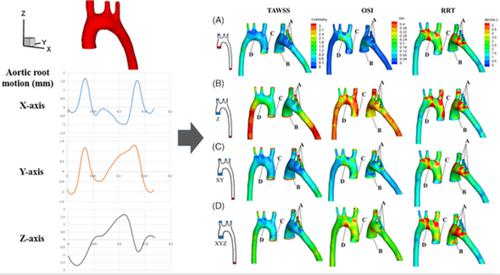当前位置:
X-MOL 学术
›
Int. J. Numer. Method. Biomed. Eng.
›
论文详情
Our official English website, www.x-mol.net, welcomes your feedback! (Note: you will need to create a separate account there.)
Numerical analysis of the hemodynamics of rat aorta based on magnetic resonance imaging and fluid–structure interaction
International Journal for Numerical Methods in Biomedical Engineering ( IF 2.1 ) Pub Date : 2021-03-22 , DOI: 10.1002/cnm.3457 Longzhu Han 1 , Quan Ren 1 , Jianxiu Lian 1 , Liyi Luo 2 , Huawei Liu 3 , Tianxiang Ma 1 , Xin Li 4 , Xiaoyan Deng 5 , Xiao Liu 1
International Journal for Numerical Methods in Biomedical Engineering ( IF 2.1 ) Pub Date : 2021-03-22 , DOI: 10.1002/cnm.3457 Longzhu Han 1 , Quan Ren 1 , Jianxiu Lian 1 , Liyi Luo 2 , Huawei Liu 3 , Tianxiang Ma 1 , Xin Li 4 , Xiaoyan Deng 5 , Xiao Liu 1
Affiliation

|
Murine models have been widely used to investigate the mechanobiology of aortic atherosclerosis and dissections, which develop preferably at different anatomic locations of aorta. Based MRI and finite element analysis with fluid–structure interaction, we numerically investigated factors that may affect the blood flow and structural mechanics of rat aorta. The results indicated that aortic root motion greatly increases time-averaged wall shear stress (TAWSS), oscillatory shear index (OSI), relative residence time (RRT), displacement of the aorta, and enhances helical flow pattern but has limited influence on effective stress, which is highly modulated by blood pressure. Moreover, the influence of the motion component on these indicators is different with axial motion more obvious than planar motion. Surrounding fixation of the intercostal arteries and the branch vessels on aortic arch would reduce the influence of aortic root motion. The compliance of the aorta has different influences at different regions, leading to decrease in TAWSS and helical flow, increase in OSI, RRT at the aortic arch, but has reversed effects on the branch vessels. When compared with the steady flow, the pulsatile blood flow would obviously increase the WSS, the displacement, and the effective stress in most regions. In conclusion, to accurately quantify the blood flow and structural mechanics of rat aorta, the motion of the aortic root, the compliance of aortic wall, and the pulsation of blood flow should be considered. However, when only focusing on the effective stress in rat aorta, the motion of the aortic root may be neglected.
中文翻译:

基于磁共振成像和流固耦合的大鼠主动脉血流动力学数值分析
鼠类模型已被广泛用于研究主动脉粥样硬化和夹层的力学生物学,它们最好在主动脉的不同解剖位置发展。基于 MRI 和流体-结构相互作用的有限元分析,我们数值研究了可能影响大鼠主动脉血流和结构力学的因素。结果表明,主动脉根部运动大大增加了时均壁剪切应力(TAWSS)、振荡剪切指数(OSI)、相对停留时间(RRT)、主动脉位移,并增强了螺旋流模式,但对有效应力的影响有限,这是高度调制的血压。而且,运动分量对这些指标的影响也不同,轴向运动比平面运动更明显。肋间动脉和主动脉弓上的分支血管周围固定将减少主动脉根部运动的影响。主动脉的顺应性在不同的区域有不同的影响,导致主动脉弓处TAWSS和螺旋流减少,OSI和RRT增加,但对分支血管有相反的影响。与稳态血流相比,脉动血流会明显增加大部分区域的WSS、位移和有效应力。总之,要准确量化大鼠主动脉的血流和结构力学,应考虑主动脉根部的运动、主动脉壁的顺应性和血流的脉动。然而,当只关注大鼠主动脉的有效应力时,主动脉根部的运动可能会被忽略。
更新日期:2021-03-22
中文翻译:

基于磁共振成像和流固耦合的大鼠主动脉血流动力学数值分析
鼠类模型已被广泛用于研究主动脉粥样硬化和夹层的力学生物学,它们最好在主动脉的不同解剖位置发展。基于 MRI 和流体-结构相互作用的有限元分析,我们数值研究了可能影响大鼠主动脉血流和结构力学的因素。结果表明,主动脉根部运动大大增加了时均壁剪切应力(TAWSS)、振荡剪切指数(OSI)、相对停留时间(RRT)、主动脉位移,并增强了螺旋流模式,但对有效应力的影响有限,这是高度调制的血压。而且,运动分量对这些指标的影响也不同,轴向运动比平面运动更明显。肋间动脉和主动脉弓上的分支血管周围固定将减少主动脉根部运动的影响。主动脉的顺应性在不同的区域有不同的影响,导致主动脉弓处TAWSS和螺旋流减少,OSI和RRT增加,但对分支血管有相反的影响。与稳态血流相比,脉动血流会明显增加大部分区域的WSS、位移和有效应力。总之,要准确量化大鼠主动脉的血流和结构力学,应考虑主动脉根部的运动、主动脉壁的顺应性和血流的脉动。然而,当只关注大鼠主动脉的有效应力时,主动脉根部的运动可能会被忽略。


























 京公网安备 11010802027423号
京公网安备 11010802027423号